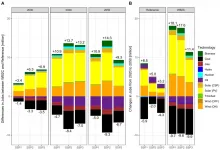(Press-News.org) July 23, 2021 - Last year, the American Cancer Society (ACS) issued an updated set of guidelines for cervical cancer screening - emphasizing the shift toward screening with primary human papillomavirus (HPV) testing. While the ACS recommendation accounts for a transition period to implement primary HPV screening, additional factors should be considered to operationalize these guidelines, according to a special white paper in the July issue of the Journal of Lower Genital Tract Disease (JLGTD), official journal of ASCCP. The journal is published in the Lippincott portfolio by Wolters Kluwer.
In the article, the ASCCP Cervical Cancer Screening Task Force voices its support for the ACS's 2020 cervical cancer screening guidelines, which include "a strong recommendation to screen with primary HPV testing." Meanwhile, the ASCCP Task Force reserves its full endorsement for the 2018 US Preventive Services Task Force (USPSTF) recommendations, which provide greater flexibility as the US healthcare system shifts to more widespread use of primary HPV screening. Jenna Z. Marcus, MD, of Rutgers New Jersey Medical School and Cancer Institute of New Jersey, Newark, is lead author of the ASCCP Task Force white paper.
During shift to primary HPV testing, ASCCP task force 'endorses any cervical cancer screening'
Coauthor Patty Cason, MS, FNP-BC notes, "Since HPV causes the vast majority of cervical cancers, testing for HPV as the primary screening test is a more effective approach to screening than cervical cytology (Pap testing)." With this approach, a cervical swab is used to test for the presence of high-risk HPV strains responsible for virtually all cervical cancers. In its 2020 guideline update, the ACS recommends the HPV test alone (primary HPV screening), for people with a cervix, beginning at age 25 and continuing through age 65.
At the current time, many patients receive care at sites where FDA-approved tests for primary HPV screening are not yet available, so this screening approach is not yet accessible to all patients. The ACS states that when FDA-approved tests for primary HPV screening are not available at a given health center, other options - co-testing with both HPV testing and cervical cytology, and cervical cytology alone - are "acceptable" alternative strategies. The ACS also suggests that these methods may be excluded from future guideline updates.
The Task Force acknowledges the benefits of primary HPV screening. "The ASCCP recognizes the need to transition to primary HPV screening and acknowledges that logistical considerations surrounding implementation, the impact of limited HPV vaccination in the United States, and inclusion of populations who may be marginalized are necessary and must be prioritized."
However, during this transition period, a flexible approach is needed to ensure maximum availability of screening. For that reason, the ASCCP Task Force endorses the 2018 USPSTF cervical cancer screening recommendations, which include "all screening modalities." The USPSTF statement provides "flexibility that may benefit those who are marginalized, underinsured, or experiencing inequity and health disparities." Through its endorsement of the 2018 USPSTF guidelines, that document is considered official ASCCP clinical guidance.
ASCCP assesses guidance from other organizations according to its Guidelines Endorsement Policy, which has three levels: endorsement, support, and comment. Endorsement indicates endorsement of a peer organization's clinical document and denotes that ASCCP fully supports the clinical guidance. Support of a peer organization's clinical document denotes that ASCCP deems the document to be of educational value to its members, although ASCCP may not agree with every recommendation or statement in the document. Comments to a peer organization's clinical document denotes that ASCCP does not agree with the recommendation, and feels the need to formally voice that opinion through public comment. In announcing its support for the 2020 ACS guidelines, The ASCCP recognizes the need to transition to primary HPV screening and acknowledges that logistical considerations surrounding implementation, the impact of limited HPV vaccination in the United States, and inclusion of populations who may be marginalized are necessary and must be prioritized.
The Task Force emphasizes the need for "sound and conservative clinical judgment" when applying the guidelines to the individual patient's situation. The authors conclude: "Most importantly, the ASCCP endorses any cervical cancer screening for secondary prevention of cervical cancer and recommends interventions that improve screening for those who are underscreened or unscreened."
INFORMATION:
Click here to read "The ASCCP Cervical Cancer Screening Task Force Endorsement and Opinion on the American Cancer Society Updated Cervical Cancer Screening Guidelines."
DOI: 10.1097/LGT.0000000000000614
About the Journal of Lower Genital Tract Disease
The Journal of Lower Genital Tract Disease is the source for the latest science about benign and malignant conditions of the cervix, vagina, vulva, and anus. The Journal's mission is to promote excellence in the healthcare of people with anogenital and HPV-related diseases, to enable healthcare professionals to be well informed, to promote the exchange of ideas, to help advance standards in the conduct and reporting of health research, and to contribute to improving health of people worldwide.
About ASCCP
ASCCP is a professional society for an interdisciplinary group of healthcare professionals including physicians, physician assistants, nurse practitioners, midwives and researchers, who are focused on improving lives through the prevention and treatment of anogenital and HPV-related diseases. For more information visit http://www.asccp.org.
About Wolters Kluwer
Wolters Kluwer (WKL) is a global leader in professional information, software solutions, and services for the clinicians, nurses, accountants, lawyers, and tax, finance, audit, risk, compliance, and regulatory sectors. We help our customers make critical decisions every day by providing expert solutions that combine deep domain knowledge with advanced technology and services.
Wolters Kluwer reported 2020 annual revenues of €4.6 billion. The group serves customers in over 180 countries, maintains operations in over 40 countries, and employs approximately 19,200 people worldwide. The company is headquartered in Alphen aan den Rijn, the Netherlands.
Wolters Kluwer provides trusted clinical technology and evidence-based solutions that engage clinicians, patients, researchers and students in effective decision-making and outcomes across healthcare. We support clinical effectiveness, learning and research, clinical surveillance and compliance, as well as data solutions. For more information about our solutions, visit https://www.wolterskluwer.com/en/health and follow us on LinkedIn and Twitter @WKHealth.
For more information, visit http://www.wolterskluwer.com, follow us on Twitter, Facebook, LinkedIn, and YouTube.
Rainforests are a powerful, natural solution to combat climate change -- providing water filtration, capturing carbon and regulating global temperatures. But major threats like large-scale land use changes, including agricultural expansion and clearcutting, have turned these biodiversity havens into one of the most endangered habitats on our planet.
In 2019, select scientists, including the University of Delaware's Rodrigo Vargas, met at the National Geographic headquarters in Washington, D.C., to discuss the threats to rainforests. The researchers pinpointed a need to develop a worldwide tracking system, which would find trends to help fight land degradation ...
Attitudes toward diversity vary, and its meaning can often be difficult to find consensus about in an increasingly diverse but politically polarized nation such as the United States.
In a report published by Personality and Social Psychology Bulletin, University of Illinois Chicago researchers detail findings from three studies that explore the connection between political ideology, attitudes, and beliefs toward diversity.
"Our studies explored the possibility that attitudes toward 'diversity' are multidimensional rather than unidimensional and that ideological differences in diversity attitudes vary as a function of diversity subtype," said the report's ...
Researchers created a global dataset of job footprints in 50 countries and used a model to investigate how trying to meet the Paris Agreement global climate target of staying well below 2°C would affect energy sector jobs. They found that action to reach said target would increase net jobs by about 8 million by 2050, primarily due to gains in the solar and wind industries. The analysis appears July 23 in the journal One Earth.
"Currently, an estimated 18 million people work in the energy industries--a number that is likely to increase, not decrease, to 26 million or by over 50% if we reach our global climate targets," says corresponding author Johannes Emmerling (@JohannesEmm), an environmental economist at the RFF-CMCC ...
Humid tropical forests, vital in global efforts to limit rising temperatures, are under threat as a result of changes in land use and climate. Now, researchers reporting in the journal One Earth on July 23 have developed a new way to keep tabs on the vulnerability of these forests on a global scale using satellite data. Called the tropical forest vulnerability index (TFVI), the hope is that this method will serve as an early warning for areas that are under the greatest threat to enable actions aimed at protecting these forests before it's too late.
"Frequent droughts, higher temperature, and longer dry seasons, along with increasing pressures from deforestation and ...
As opioid overdose deaths rose during the COVID-19 pandemic, people seeking treatment for opioid addiction had to wait nearly twice as long to begin methadone treatment in the United States than in Canada, a new Yale study has shown.
In both countries during the pandemic, about one in 10 methadone clinics were not accepting new patients and a third of those cited COVID-19 as the reason, according to research published July 23 in the journal JAMA Network Open.
An estimated 90,000 people in the United States died from drug overdoses last year.
"We missed opportunities to save lives," said Paul Joudrey, assistant professor of internal medicine at the Yale School of Medicine and corresponding author of the paper.
The findings highlight shortcomings providing prompt ...
EVANSTON, Ill., --- One of the keys to a long life may lie in your net worth.
In the first wealth and longevity study to incorporate siblings and twin pair data, researchers from Northwestern University analyzed the midlife net worth of adults (mean age 46.7 years) and their mortality rates 24 years later. They discovered those with greater wealth at midlife tended to live longer.
The researchers used data from the Midlife in the United States (MIDUS) project, a longitudinal study on aging. Using data from the first collection wave in 1994-1996 through a censor date of 2018, the researchers used survival ...
From the thrill of hearing an ice cream truck approaching to the spikes of pleasure while sipping a fine wine, the neurological messenger known as dopamine has been popularly described as the brain's "feel good" chemical related to reward and pleasure.
A ubiquitous neurotransmitter that carries signals between brain cells, dopamine, among its many functions, is involved in multiple aspects of cognitive processing. The chemical messenger has been extensively studied from the perspective of external cues, or "deterministic" signals. Instead, University of California San Diego researchers recently ...
What The Study Did: Researchers investigated the association between net worth at midlife and subsequent longevity in individuals as well as with siblings and twins.
Authors: Eric D. Finegood, Ph.D., of Northwestern University in Evanston, Illinois, is the corresponding author.
To access the embargoed study: Visit our For The Media website at this link https://media.jamanetwork.com/
(doi:10.1001/jamahealthforum.2021.1652)
Editor's Note: The article includes conflicts of interest and funding/support disclosures. Please see the article for additional information, including ...
What The Study Did: Using survey responses from students in some Pittsburgh, Pennsylvania, high schools, researchers investigated how experiences of bullying based on race/ethnicity/national origin and other marginalized identities are associated with outcomes for health, mental health and violence among adolescents.
Authors: Chardée A. Galán, Ph.D., of the University of Pittsburgh, is the corresponding author.
To access the embargoed study: Visit our For The Media website at this link https://media.jamanetwork.com/
(doi:10.1001/jamanetworkopen.2021.16364)
Editor's Note: The article includes conflict of interest and funding/support disclosures. Please see the article for additional ...
Hershey, Pa. -- Financial instability, lack of infrastructure, a deteriorating sense of community and family fragmentation are key contributors to diseases of despair in Pennsylvania communities, according to Penn State College of Medicine and Highmark Health researchers. The researchers conducted four focus groups in Pennsylvania communities identified as having high rates of despair-related illnesses.
Diseases of despair are medical diagnoses involving alcohol-related disorders, substance-related disorders and suicidal thoughts and behavior. Princeton economists Anne Case and Angus Deaton proposed the concept of deaths of despair in 2015 after observing a decline ...



